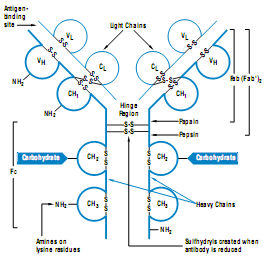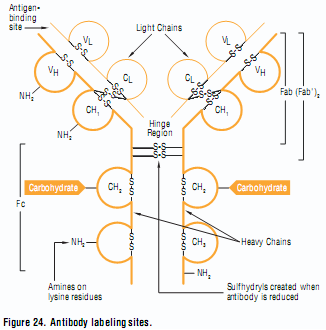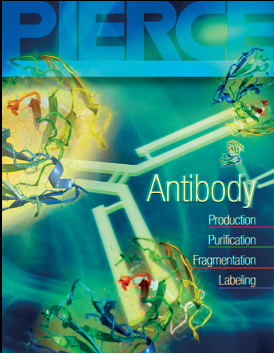|
|
Main » Entries archive
EZ-Link ® Biotinylation Reagents The highly specific interaction of avidin with biotin (vitamin H) can be a useful tool in designing nonradioactive purification and detection systems. The extraordinary affinity of avidin for biotin (Ka = 10)is the strongest known non-covalent interaction of a protein and ligand and allows biotin-containing molecules in a complex mixture to be discretely bound with avidin conjugates. Pierce offers an extensive line of biotinylation reagents, conjugates and affinity supports that exploit this unique interaction. Some applications in which the avidin-biotin interaction has been used include ELISA; immunohistochemical staining; Western, Northern and Southern blotting; immunoprecipitation; cell-surface labeling; affinity purification; and fluorescence-activated cell sorting (FACS). Biotin, a 244 dalton vitamin found in t
...
Read more »
Views: 6531 |
Added by: anis |
Date: 2009-09-16
|
|
Overview Antibodies, like other proteins, can be covalently modified in many ways to suit the purpose of a particular assay. Many immunological methods involve the use of labeled antibodies, and a variety of reagents have been created to allow labeling of antibodies. Enzymes, biotin, fluorophores and radioactive isotopes are all commonly used to provide a detection signal in biological assays. Covalently attaching such a label to an antibody combines the unique specificity of the antibody with a sensitive means for detection, thus creating an ideal probe molecule. Aside from antibodies, these same labels can be attached to avidin, streptavidin, Fc-binding proteins such as Protein A or G, and many other proteins. Full PDF
...
Read more »
Views: 818 |
Added by: anis |
Date: 2009-09-16
|
|
Overview
Antibodies are proteins; therefore, methods of purification from biological samples (serum, ascites fluid or culture super-natant) are really specialized forms of general protein purification methods (see the Protein Purification section of the Pierce TechnicalHandbook and Catalog). Antibody purification can be rather crude (as in precipitation of a fraction containing immunoglobulins and other proteins), particular to immunoglobulins as a group or highly specific to only those antibodies in a sample that bind to a given antigen. Full PDF
Views: 807 |
Added by: anis |
Date: 2009-09-16
|
|
Antibody

Antibodies are host proteins that are produced by the immune system in response to foreign molecules that enter the body. These foreign molecules are called antigens, and their molecular recognition by the immune system results in selective production of antibodies that are able to bind the specific antigen. Antibodies are made by B lymphocytes and circulate throughout the blood and lymph where they bind to their specific antigen, enabling it to be cleared from circulation. This ability of animal immune systems to produce antibodies capable of binding specifically to antigens can be harnessed to manufacture probes for detection of molecules of interest in a variety of research and diagnostic applications. No other current technology allows researchers to design and manufacture such highly specific molecular recognition tools. In addition to th
...
Read more »
Views: 772 |
Added by: anis |
Date: 2009-09-16
|
|
Protein Array Technology
The principles of microspot array technology were first described more than a decade ago. Ekins, et al (1) explained why microspot assays are more sensitive than any other ligand binding assay in the “ambient analyte theory.” Much of the initial work was done on microspot immunoassays. The first widespread successful biological application of these microspot assays in the form of microarrays was in the area of molecular biology. From the very beginning, the power of generating data on a whole genome basis with the DNA microarray or ‘chip’ was realized. Now that the genetic structure and function of many species have been completed or are well on the way to completion, the next logical step is microarray-based proteome analysis. Proteome analysis is fundamentally different than genetic analysis in that there
...
Read more »
Views: 872 |
Added by: anis |
Date: 2009-09-16
|
|
Advancing Justice Through DNA Technology
EXECUTIVE SUMMARY
DNA technology is increasingly vital to ensuring accuracy and fairness in the criminal justice system. DNA can be used to identify criminals with incredible accuracy when biological evidence exists, and DNA can be used to clear suspects and exonerate persons mistakenly accused or convicted of crimes. The current federal and state DNA collection and analysis system needs improvement. In many instances, public crime labs are overwhelmed by backlogs of unanalyzed DNA samples. In addition, these labs may be ill-equipped to handle the increasing influx of DNA samples and evidence. The problems of backlogs and the lack of up-to-date technology result in significant delays in the administration of justice. More research is needed to develop faster methods for analyzing DNA evidenc
...
Read more »
Category: JOURNAL |
Views: 874 |
Added by: anis |
Date: 2009-09-16
|
|
James R. Brown and Philippe SanseauDDT • Volume 10, Number 8 • April 2005 Small non-coding RNAs called microRNAs have been shown to play important roles in gene regulation across a broad range of metazoans from plants to humans. In this review, the nature and function of microRNAs will be discussed, with special emphasis on the computational tools and databases available to predict microRNAs and the genes they target. Full PDF
Category: JOURNAL |
Views: 752 |
Added by: anis |
Date: 2009-09-16
|
|
Views: 872 |
Added by: anis |
Date: 2009-09-15
|
|
Views: 11818 |
Added by: anis |
Date: 2009-09-15
|
|
Views: 2966 |
Added by: anis |
Date: 2009-09-15
|
|
|
| Calendar |
|---|
| « April 2024 » | | Su | Mo | Tu | We | Th | Fr | Sa | | | 1 | 2 | 3 | 4 | 5 | 6 | | 7 | 8 | 9 | 10 | 11 | 12 | 13 | | 14 | 15 | 16 | 17 | 18 | 19 | 20 | | 21 | 22 | 23 | 24 | 25 | 26 | 27 | | 28 | 29 | 30 |
|
| Statistics |
|---|
Total online: 1 Guests: 1 Users: 0 |
|

